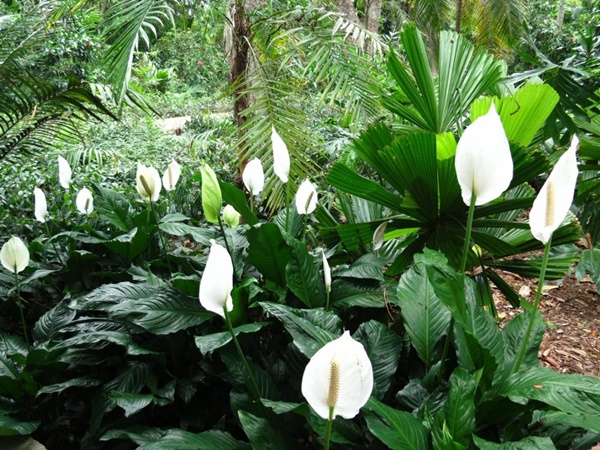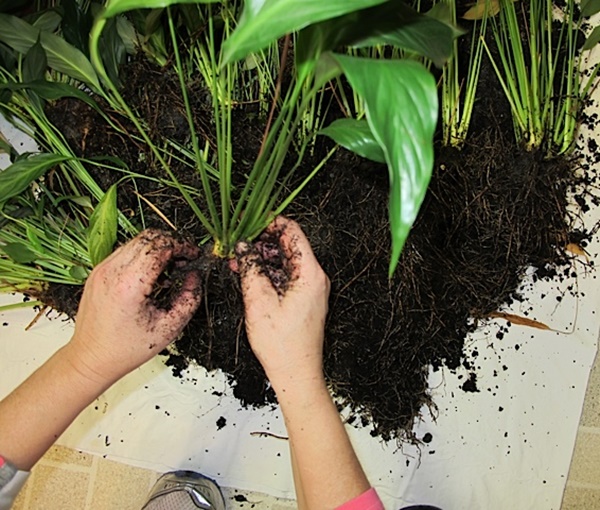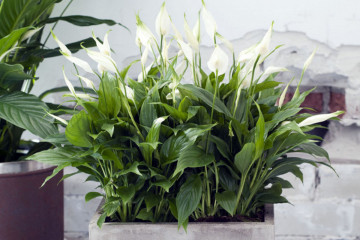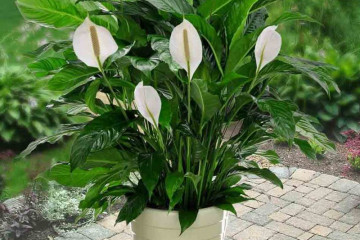Spathiphyllum flower - reproduction at home
Content:
Referring to beautifully flowering plants, spathiphyllum is very popular. This is facilitated by ease of care, decorativeness, the ability to create a favorable atmosphere in the home. With a little care, you can get significant results. Many are interested in how to propagate spathiphyllum. Although the procedure does not require a lot of experience, knowledge of the methods and adherence to the rules are essential.
general description
The oval leaves of the plant with a pointed end grow from the ground, the stem is absent in many species. Cuttings grow from the rhizome with foliage from 15 cm to 1.5 m in height. The purpose of spring bloom is to attract insects for pollination and seed development. Sometimes the process is observed repeatedly throughout the year. In the plant world of the tropics and subtropics, spathiphyllum is located on the lower tier. He lacks tolerance to bright sunlight. In its complete absence, the flowering period can be halved.
The plant feels good in the shade, prefers diffused light. When bright direct rays fall on it, the leaves fade and dry out. Based on this pattern, a north, west or east window is chosen to place the culture in the house.
In Europe, spathiphyllum appeared by the end of the 19th century, when it was brought from the jungle of America. The discoverer is considered the German explorer G. Wallis, after whom one of the varieties is named.
How spathiphyllum reproduces in vivo
How does the spathiphyllum flower reproduce? It is interesting to learn about this process in natural conditions. The native land of the plant is South America, it is also present in the tropics of Asia, the Philippines, and Central America. It is located in the shade of large trees and along swampy river banks. Wildlife reveals dozens of species, differing in size and color of the petal (sails). In home floriculture, only white specimens with endurance take root.
For successful reproduction with rosettes and seeds, the plant needs not so much light and temperature (from 15 to 32 degrees), but sufficient humidity of the environment, as well as the absence of drafts and cooling of the soil. Reproduction by seeds is practically possible only in nature, when they immediately fall into a favorable environment for germination. The vegetative method (cuttings, rosettes) is also possible indoors with significant root growth.
Requirements for the conditions of detention
With too little light, foliage will not change in a very favorable way. Although it thickens, it becomes shallow and stretches. Successful reproduction, as well as flowering, which, in a favorable case, pleases with its duration, are questionable. New plants do not take root with a lack of lighting.
At home, I want spathiphyllum to both propagate and get a stable flowering, a healthy look. The way out is in observing natural conditions. In addition to choosing a window sill, you can add backlighting with a conventional lamp. Her plant perceives favorably.
There are other requirements that ensure a favorable breeding of spathiphyllum:
- Room temperature. When it drops by less than + 18 ° C, development stops. Spathiphyllum and its process require 22 or 23 degrees for survival. The issue can be solved with a mini-greenhouse.
- Drafts lead to disease even in an adult plant, especially young ones will suffer from them.
- Soil moisture is required significant, without drying out, otherwise the leaf will wilt. But also excesses, stagnant moisture lead to the death of the roots. The foliage in this case is covered with dark spots.
Young seedlings are very sensitive to the moisture regime. Injury can also kill her. The natural growing environment is humid air conditions. In the room, the plant will require spraying. It will reproduce better in a greenhouse. Natural ways to grow a plantation are rhizome overgrowth. New rosettes form at the base of the plant, and natural sowing also occurs after flowering.
Features of reproduction at home
This representative of Aroids is somewhat poisonous and can cause allergies. When handling him, you need to beware of dermatitis. But it does not emit harmful substances into the air. On the contrary, it perfectly cleanses the environment. To create such an effect, there should be about 7 copies in one room.
Getting additional plants is not a problem. Those who like this culture can reproduce an existing specimen of spathiphyllum. Even beginner home botanists will cope with a simple action.
In order for the procedure to be successful, you must follow the rules. Noticing good growth, the florist is interested in how spathiphyllum can be propagated at home.
Three types of planting material are obtained from an adult specimen:
- seeds;
- cuttings;
- parts of the bush for dividing.
People who like the spathiphyllum in the house decide to expand the plantation. It is important to avoid a number of common mistakes. The most popular breeding methods are cuttings or rhizome splitting. Seeds of indoor spathiphyllum are also used, sowing them. This method is less common due to a number of difficulties.
A feature of plant care is the need for regular transplantation. This process is advisable to use for simultaneous reproduction.
A step-by-step guide to propagating by cuttings
The success of vegetative reproduction is very likely, it is applicable to almost all representatives of the flora. Dividing a bush is a simple process and must be done with care. The secret of the growing season is that the formation of "children" at the base allows you to successfully transplant. The rosette of leaves has small roots; in the spring they are easily separated.
Sequencing:
- It is necessary to inspect and find vegetative material (rosettes, processes).
- Small shoots that have emerged from the soil are up to 3 cm in size.If they are not separated, they will increase in size and form a new large rosette. Using a sharp knife, they are cut off along the connecting spine in one motion.
- The offspring is taken out, examined to see if there are roots, and then planted in the ground. Usually they make a greenhouse or greenhouse for adaptation. If there is no root system, it can be pre-grown in a container with water.
From the stems
The method of how to propagate spathiphyllum by cuttings and how to take a shoot is not the only one possible during the growing season. The indoor flower is also subjected to rhizome division.
Step by step method:
- The spring period is selected simultaneously with the necessary transplant.
- The rhizome is cut with a sharp knife. The cuts are sprinkled with charcoal (not activated).
- Separate stems are obtained, which are planted under a transparent cap.
Root cuttings take root in almost every case, but only experienced florists carry out the procedure correctly. The risk of spoiling the original plant is very high.
From the leaves
Spathiphyllum propagation by a leaf like begonia is impossible. Simply dipped in water or buried in the ground, it does not give roots, it dies. Therefore, the method does not apply to this culture.
How to germinate spathiphyllum shoots in water
Rosettes with leaves and small roots can be held in a container of water. Over time, the root system will grow.
The flower is planted in a separate container and the necessary conditions for watering, temperature (about 22 degrees), lighting are created.
Instructions for growing from seeds
The seed propagation method is not reliable. In most cases, success is not achieved. This is considered possible in theory:
- Artificial pollination will be required, which not everyone succeeds in at home.
- Low germination, especially over time. You can only hope with immediate sowing.
- Peat and sand soil does not guarantee optimal moisture and ventilation conditions, even if you create a greenhouse.
For all these reasons, it is easier for a grower to propagate a crop using vegetative methods.
How to properly divide spathiphyllum during transplantation
How to properly divide spathiphyllum during transplantation? The roots must be untangled, being careful not to damage. You can root cuttings in perlite, wet sand. It is recommended to cover each bush with a transparent cap with ventilation holes or regular ventilation. After each cutting has strengthened the root system, it is transferred to a substrate from turf, peat, sand, leafy soil, 1: 2: 1: 2.
When considering how spathiphyllum reproduces, we mean its many advantages. It combines attractiveness with the ability to make the air cleaner. Using the outlined methods and rules, it will be easy to cope with this procedure.



















